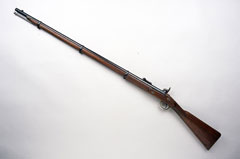
Online Collection
« Prev - 1 of 1 results - Next »
Enfield Pattern 1853, .577 inch Percussion Rifle Musket, 1854
Trials to produce a lighter, reduced bore firearm resulted in the adoption of the Enfield Rifle Musket as the new pattern for the infantry in 1853. The Pattern 1853 Enfield had an effective range of 800 to 1,000 yards (731 to 914 metres).
In 1856 the East India Company ordered around 10,000 of these rifle muskets. The adoption of this weapon was to play a key role in the outbreak of the Indian Mutiny (1857-1859). Rifled with three grooves and fastened to the stock with three metal bands, the rifle was often called a 'three band' model. It had already performed well in the Crimean War (1854-1856).
NAM Accession Number
NAM. 1979-07-60-1)
Copyright/Ownership
National Army Museum Copyright
Location
National Army Museum, Conflict in Europe gallery
Object URL
https://collection.nam.ac.uk/detail.php?acc=1979-07-60-1%29


